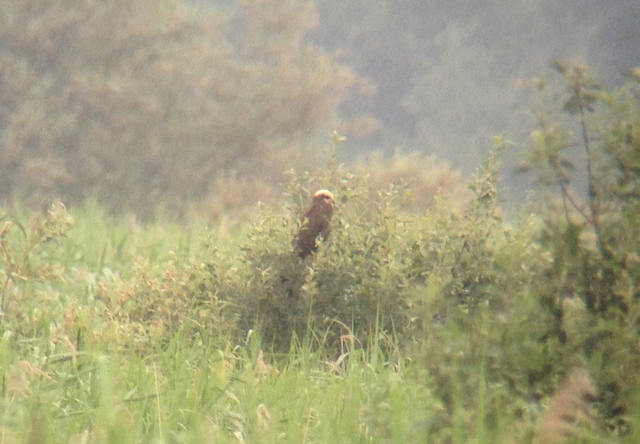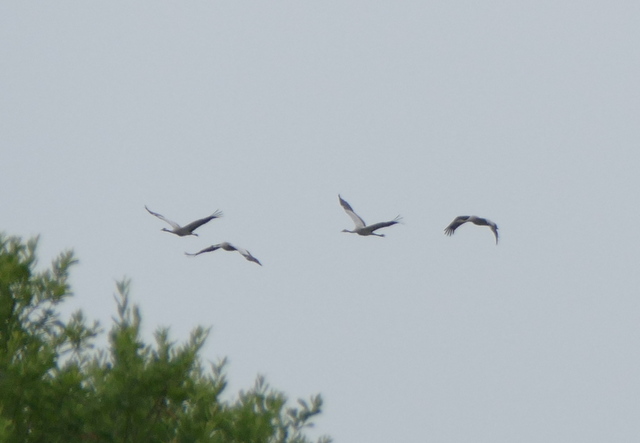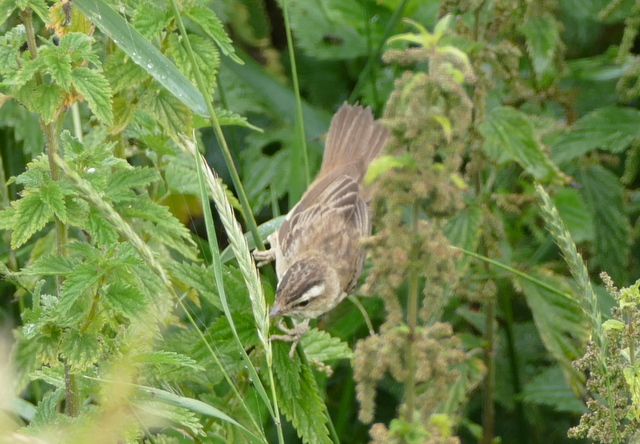Day 1 of a long weekend of tours today and we were bound for the Brecks. The weather forecast wasn’t great – and for once unfortunately it was right!! – but we made the most of a bright morning and got all the target birds before the worst of the afternoon rain.
We stopped off at Weeting Heath briefly. The pines were quiet again today, apart from a single Goldcrest singing. However, it was the Stone Curlews we were really after and there were several on show as we got into the hide, including a couple that were fairly close. With the early start and the cool cloudy conditions meaning little in the way of heat haze today, we got a good look at them through the scope. We admired the bright yellow iris and black and white striped wing panel.
 Stone Curlew – one of several at Weeting Heath today
Stone Curlew – one of several at Weeting Heath today
While the grass is kept closely cropped by the resident rabbits, the ragwort is now getting quite tall. Over on the ridge, it is also quite thick, making it difficult to count the total number of Stone Curlews present. We could see at least seven, the maximum simultaneously in view at any one time. They were also quite vocal at times – we could hear where they got one of their old names ‘wailing heath chicken’! Following the sound, we could eventually see five Stone Curlews chasing round in a group among the ragwort.
There were not so many other birds to see. A little group of Lapwing were out in the grass. A single Mistle Thrush appeared nearby and ran in and out of the ragwort clumps feeding. We could hear a Green Woodpecker yaffling and it flew up onto the trunk of a pine tree briefly before disappearing over the field beyond. We wanted to make the most of the dry weather, so we moved swiftly on.
It was cloudy and cool at Lakenheath as we arrived. Walking out along the main path, a Cetti’s Warbler called from the sallows and then flew across in front of us. A couple of Reed Warblers sang half-heartedly from the reeds and a Blackcap did the same from the trees.
New Fen Viewpoint once again seemed a little quiet at first, apart from the family of Coot and a couple of Mallard. As we stood and watched, we could see Reed Warblers coming out to feed along the edge of the reeds. We could hear Bearded Tits calling and, as they made their way in our direction we could see the reeds shaking vigorously. However, rather than coming out in front of us they suddenly took to the air and flew off in the opposite direction.
We hadn’t been there long when one of the group spotted a shape flying over the tops of the reeds – a Bittern. It made a lovely long feeding flight – all the way from the back of New Fen almost to the north-east corner, giving us a great chance to get a good look at it. A perfect start!
As we walked out across the reserve, we could see the darker clouds arriving from the west. There were still a few dragonflies and damselflies out, despite the cool weather – plenty of Ruddy Darter and Blue-tailed Damselflies. And a smattering of butterflies – a couple of Gatekeepers and a rather faded Ringlet.
 Blue-tailed Damselfly – a few still out today, despite the cool weather
Blue-tailed Damselfly – a few still out today, despite the cool weather
As we got out almost to the Joist Fen Viewpoint, it started to rain. Thankfully it was only light and not enough to stop us. However, raptor activity was decidedly limited. A Kestrel came out of West Wood as we walked past. A Common Buzzard flew low, back past us in the direction of the trees. A single juvenile Marsh Harrier sat perched in one of the bushes.
 Marsh Harrier – this juvenile was hiding in the bushes at Joist Fen
Marsh Harrier – this juvenile was hiding in the bushes at Joist Fen
The sky was a little brighter to the west, so we decided to make a bid for the open exposed height of the river bank. The Cranes seem to be spending more of their time over the other side of the river now that the young have fledged, so we wanted to at least have a chance to look for them before the weather deteriorated further. A Reed Bunting was feeding in the umbellifer heads along the edge of the path as we walked past.
 Reed Bunting – feeding in the umbellifer heads in the rain
Reed Bunting – feeding in the umbellifer heads in the rain
It was fairly quiet along the river today. A couple of Grey Herons stood on the bank and two Little Egrets flew up from Joist Fen and disappeared over into Norfolk. A Common Tern perched on its usual fence post just over the other side. We flushed a Common Whitethroat from the overgrown vegetation by the path and it flew up into one of the large sallows.
We did see more Bitterns. From up on the river bank, one flew up from Joist Fen and headed back in the direction of the viewpoint. Again, it was in the air for a long time before we lost it behind the trees – another great, long flight. Then yet another Bittern, this one a slightly darker bird, flew up from the same area. This time it headed over towards the railway line before dropping down out of view. Such a privilege to see so much Bittern action and a testament to the success of the habitat creation at Lakenheath Fen.
All the time, as we walked along the river bank, we scanned the fields the other side for any sign of the Cranes. Unfortunately, we just couldn’t find them there today. Finally, with everyone getting slightly damp now, we reluctantly turned to head back. But we were not to be disappointed! We hadn’t gone too far when a quick glance over the shoulder revealed four large birds flying straight towards us from further out across the fields. Cranes!
 Cranes – flying towards us over the fields across the river
Cranes – flying towards us over the fields across the river
As they got over their favoured fields, the four Cranes turned and headed west. We could see that they were the family of four – two adults and their two recently fledged juveniles. We watched them for some time until they finally disappeared behind the trees. Great stuff!
 Cranes – two adults in front and their two juveniles following behind
Cranes – two adults in front and their two juveniles following behind
It is such a pleasure to see the young Cranes flying here. After a few years with no success, both of the Lakenheath Fen pairs of Cranes have raised young this year – the twins we saw today and a single juvenile for the second pair.
Even better, it had stopped raining by now, if only for a little bit. As we walked back along the bank, there were lots of warblers feeding amongst the vegetation by the path. Presumably, the reeds were now very wet and the more open plant life here was a more attractive option. We had great views of both Reed Warblers and several Sedge Warblers.
 Sedge Warbler – feeding along the river bank path in the rain
Sedge Warbler – feeding along the river bank path in the rain
We headed back swiftly across the reserve. The rain had started again by the time we got to the New Fen Viewpoint so we paused to catch our breath in the shelter. We heard a Kingfisher calling and saw it briefly flying across the reeds before it dropped down into a channel out of view. A short while later, it was off again and flew over to the pool in front of us. It landed for a second on the reeds at the edge, but didn’t find its footing and flew once more. Unfortunately this time, it headed out to the back of the pool and disappeared into the reeds.
A single male Marsh Harrier was perched on a dead stump across New Fen. We got it in the scope and had a good look at it – it didn’t seem particularly impressed by the weather! Eventually it took off and circled over the reeds for a while, before turning and heading back across the reserve and out of sight. We took that as a cue to leave ourselves.
 Marsh Harrier – this male perched up in the rain
Marsh Harrier – this male perched up in the rain
Back at the visitor centre, we settled in to dry out and enjoy a late lunch. The feeders just outside provided a welcome distraction from the weather – a steady stream of Blue Tits and Great Tits, Chaffinches, Goldfinches and Greenfinches dropped in to feed, plus the odd Reed Bunting. Some of them were looking decidedly wet!
 Greenfinches – looking rather wet on the feeders
Greenfinches – looking rather wet on the feeders
However, the highlight was the juvenile Great Spotted Woodpecker which appeared and hung on the peanuts for a while.
 Great Spotted Woodpecker – a red-crowned juvenile
Great Spotted Woodpecker – a red-crowned juvenile
The rain was showing no signs of easing, but we decided to have a go at getting out again. Lynford Arboretum seemed like a good option, with the trees offering the possibility of some shelter. However, as we walked round the main part of the arboretum there were very few birds to look at – we could hear a few Goldcrests but not see them in the densest fir trees. A single Siskin perched in the top of a conifer briefly.
There was a little more activity down around the lake. We found several Little Grebes on the water – two fully grown juveniles near the bridge and an adult feeding a younger juvenile below the Hall. A mixed tit flock in the alders was easy to hear but proved harder to see – we glimpsed Long-tailed Tits, Coal Tits and a Treecreeper. Time was getting on – and we were getting wet – so we decided to head back and call it a day.
Thankfully we had made the most of the morning and seen all the main target birds, despite the weather – Stone Curlews, Cranes and Bitterns.
















